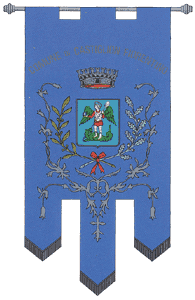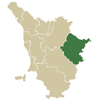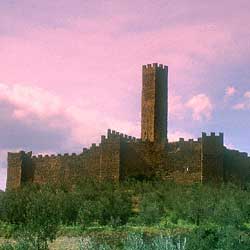|
 Inhabitants
in 1991 : 11,410 Inhabitants
in 1991 : 11,410
 The
Municipal territory of Castiglion Fiorentino, in the Val di Chiana,
extends over an area of 111,25 square kilometres comprising the Alluvial
Plain of the Chiana canal and a hilly zone between the hillock which separates
the Val Tiberina from the valley line path of the Umbro-Casentinese highway.
A feudal centre, then a liberal municipality, then a Podesta office,
it became a community in 1774. The
Municipal territory of Castiglion Fiorentino, in the Val di Chiana,
extends over an area of 111,25 square kilometres comprising the Alluvial
Plain of the Chiana canal and a hilly zone between the hillock which separates
the Val Tiberina from the valley line path of the Umbro-Casentinese highway.
A feudal centre, then a liberal municipality, then a Podesta office,
it became a community in 1774.
Noted for the first time in the X century with the name of Castiglione,
it was originally a feudal of the Marquis di Monte Santa Maria ;
only towards the end of the XII century the name of “Aretino”
would have been added to indicate its affiliation to the diocese of
Arezzo,
even though the castle remained under the direct authority of the Empire,
as was proved by a certificate of Emperors Enrico VI in 1196 and Federico
II in 1225. Already in that year Castiglione seemingly governed as
a free municipality with its own district stipulating treatise and covenants,
such as that of 1198 which predicted, in exchange for peace and
protection by Arezzo, an annual payment per head by the men of
Castiglione. If consequences of the battle of Montaperti aggravated
the intervention of the centre by the Arezzo
Ghibellina, after that of Campaldino in 1289 Firenze assumed the
role of interested protector, sending a stable military garrison
and Fiorentini Podesta. In 1303, Arezzo
with Bishop Guido Tarlati managed to re-conquer the castle and his
brother Pietro Saccone governed with the office of Imperial Representative
from 1313 until Castiglione, in 1336, returned under the dominion of
Firenze. In 1343, after the exile of Duke d’Atene from Firenze,
the Fiorentini Regents then in office sold Castiglione to Pier Saccone
of the Tarlati for 7,000 florins ; but soon after the Perugini
became Lords and occupied and maintained Castiglione until 1370, when
Pope Urbano V placed the castle under the direct jurisdiction of the Holy
See. Castiglione assumed its present name definitively in 1384,
when it passed, with all the Arezzo
territory, under the dominion of the Fiorentina Republic.
 Plundered
in 1409 by the troops of Ladislao di Durazzo, at war with Firenze, it
was thus partially reimbursed by the Government of the dominant Firenze
in the form of a reduction in taxes, and in 1432 it acquired from the
Fiorentini the lake of Brolio. It suffered grave damage again in 1452
caused by the permanence in the territory of the troops of Alfonso King
of Napoli in war against Firenze ; other warlike episodes marked
the history of Castiglione: after a revolt by the peoples of Castiglione
against the Fiorentino Government in 1502, in 1529 it resisted at length
before being tricked into surrendering to the Imperial troops of
Carlo V, and in 1554, during the war which brought on the capitulation
of Siena, it fell briefly in the hands of the antifiorentine forces
led by the exiled Piero Strozzi. From then on it followed the general destiny
of the Mediceo State, marking it as one of the most important
centres of the Arezzo
territory, also under the cultural aspect, as demonstrated by a small
group of illustrious Castiglionese (some even expatriates) who lived in
the XVII and XVIII centuries. Plundered
in 1409 by the troops of Ladislao di Durazzo, at war with Firenze, it
was thus partially reimbursed by the Government of the dominant Firenze
in the form of a reduction in taxes, and in 1432 it acquired from the
Fiorentini the lake of Brolio. It suffered grave damage again in 1452
caused by the permanence in the territory of the troops of Alfonso King
of Napoli in war against Firenze ; other warlike episodes marked
the history of Castiglione: after a revolt by the peoples of Castiglione
against the Fiorentino Government in 1502, in 1529 it resisted at length
before being tricked into surrendering to the Imperial troops of
Carlo V, and in 1554, during the war which brought on the capitulation
of Siena, it fell briefly in the hands of the antifiorentine forces
led by the exiled Piero Strozzi. From then on it followed the general destiny
of the Mediceo State, marking it as one of the most important
centres of the Arezzo
territory, also under the cultural aspect, as demonstrated by a small
group of illustrious Castiglionese (some even expatriates) who lived in
the XVII and XVIII centuries.
Places to visit :
The Central Piazza, in the renaissance stamp and embellished
by the “Logge del Vasari” of the XVI century. Decorated
with coats of arms in stone or terracotta of Commissioners and Podesta,
and by an antique fresco. In front of the Logge is the Town-hall erected
in 1500 and renewed in 1935.
The Municipal Art Gallery , housed since 1991 in the antique
“Cassero” (XI-XII century), it is a rich collection of
works coming from the local churches. The building includes the Church
of S. Angelo, enclosed in the museums path, where, other than the
paintings from 1200 to1400 one can admire three masterpieces by a
medieval goldsmith.
S Lazzo in S . Stefano, ex church, the building goes back
to 1350 and its interior is entirely covered with frescos.
Parish Church of Rétina , built on a previous installation
of the XII -XIII centuries and has a renaissance form with three naves.
Montecchio Vesponi Castle, positioned on the road which connects
Castiglion Fiorentino to Cortona, it was donated by Firenze to the
leader of the mercenary troops Giovanni Acuto after the battle of
Campaldino. |
Historical info reproduced upon authorization
of Regione Toscana - Dipartimento della Presidenza E Affari Legislativi
e Giuridici
Picture by Sandro Santioli
Translated by Ann Mountford
|